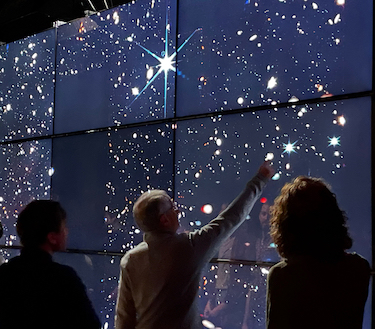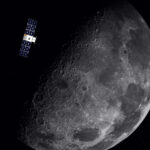Stallion has a new look!
Stallion — one of the highest-resolution tiled displays in the world — has been used by researchers to study impactful data such as the earliest galaxies ever observed from the James Webb Space Telescope and flu variants during the COVID-19 pandemic.
Clicking on the “Read Full Article” link below will auto-scroll you to the full article (same page).

NEW YEAR, NEW STALLION
High-res display system enables researchers to zoom in and analyze data in eye-catching detail
Stallion — one of the highest-resolution tiled displays in the world — has been used by researchers to study impactful data such as the earliest galaxies ever observed from the James Webb Space Telescope and flu variants during the COVID-19 pandemic.
UT Austin Department of History Professor Adam Clulow has high praise for Stallion's performance.
“Discovering Stallion has been a game-changer for me,” Clulow said. “The new Stallion is ideal for showcasing Virtual Angkor, our fully realized recreation of the Cambodian metropolis of Angkor around 1300 CE. Stallion brings this work to life allowing viewers to see the most minute of details.”
Located in the TACC POB Visualization Laboratory (Vislab) on UT Austin's main campus, the new system consists of 18 65-inch Samsung 8K QLED monitors, increasing the resolution from 328 megapixels to 597 megapixels.
“This was the right time to upgrade Stallion,” said Paul Navrátil, TACC's Director of Strategic Technologies. “We're doing so at the beginning of a technology curve in 8K televisions which will allow us to maintain a solid technological basis.”
TACC Visualization Specialist Jo Wozniak helped install the original rendition of Stallion in 2008.
“A system like Stallion is more than just an end-stage display,” Wozniak said. “With Stallion now offering a more effective display and greater brightness, researchers can easily discover previously unnoticeable details versus what would be seen using the earlier system or the monitors on their personal computers.”
Stallion was previously built on five-column framing with columns running both horizontally and vertically. With 80 monitors, the original Stallion was impressive, but was hardwired to be a single unit and presented as one large, immobile display.
The upgraded version is built on a three-row, six-column frame with each column holding three monitors — each row can abut next to each or be separated to make viewing research easier and more intuitive.
Experts on TACC's Visualization team also developed software such as DisplayCluster and MostPixelsEver: Cluster Edition to allow the distributed display to be easily controlled.
The system allows users access to more than 74 gigabytes of graphics memory, 1.28 terabytes (TB) of system memory, 19TB aggregate local disk storage, and 232 processing cores. This configuration enables the processing of datasets at a larger scale, and the interactive visualization of substantial geometries.
The Cosmic Evolution Early Release Science Survey (CEERS) team investigated their data taken by the James Webb Space Telescope on TACC's Stallion system. This image shows a region of the sky smaller than the area of the full moon, which contains ~100,000 galaxies, including some of the most distant galaxies known to humankind.
For corrections or follow-up: editor@bizzinfohub
You may like these posts too:
- Splashdown! NASA’s Orion Returns from Historic Mission
- NASA Creates In-Space Servicing, Assembly, Manufacturing Consortium
- NASA Awards Grants to Support Research, Technology Development
- Evolution Space Passes Karman Line and Completes Successful First Space Mission
- A New Era for Space Travel and Lunar Exploration Has Begun
- View NASA’s Top 100 Images for 2022 – Part 6














